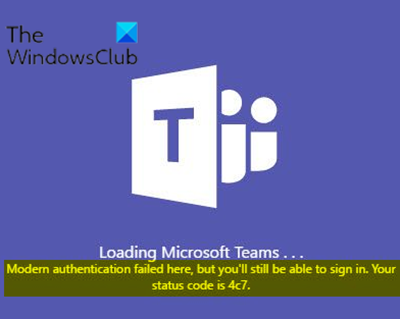Microsoft Teams is a unified communication and collaboration platform that combines persistent workplace chat, video meetings, file storage, and application integration. If when you try sign in to Microsoft Teams when you connect from a corporate network in which Active Directory Federation Services (AD FS) is installed and you encounter the “Modern authentication failed” error message, then this post might interest you. In this post, we will identify the potential cause and as well provide the possible solution that you can try to help resolve this issue.

Modern authentication failed, Status code 4c7 – Microsoft Teams
When the authentication fails, you’ll receive the error message as described below:
Modern authentication failed here, but you’ll still be able to sign in. Your status code is 4c7.
And if you check the logs, you may see information similar to the following:
DateTime< 7124> — info — SSO: SSO requires credential. Status: caa10001. Attempting windows auth.
DateTime< 7124> — info — SSO requires credential. Status: caa10001. Attempting windows auth. diag:1
DateTime<7124> — info — SSO: (Non domain joined) No user present. Status: 3399548929
DateTime<7124> — error — SSO: ssoerr – (status) Unable to get errCode. Err:Error: ADAL error: 0xCAA10001SSO: ssoerr – (status) Unable to get errorDesc. Err:Error: ADAL error: 0xCAA10001
To resolve the Modern authentication failed – Status code 4c7 error message, you will have to enable Forms Authentication by using the AD FS Microsoft Management Console (MMC) snap-in on the computer that has the local copy of Active Directory. To do this, follow these steps:
- In the navigation pane, browse to Authentication Policies.
- Under Actions in the details pane, select Edit Global Primary Authentication.
- On the Intranet tab, select Forms Authentication.
- Select OK (or Apply).
According to Microsoft, this error occurs because Microsoft Teams requires Forms Authentication. When you deploy AD FS, Forms Authentication is not enabled for the intranet by default.
Form-based authentication is a term of art in the context of Web and Internet-based online networked computer systems. In general, it refers to the notion of a user being presented with an editable “form” to fill in and submit in order to log into some system or service.
The advantage of form authentication is that users do not have to be a member of a domain-based network to have access to your application. So the number of web applications uses the form of authentication in their web application.
There are three types of authentication in ASP.NET viz:
- Windows authentication
- Forms authentication
- Passport Authentication
If Windows Integrated Authentication fails, you are prompted to sign in by using Forms Authentication.
Leave a Reply